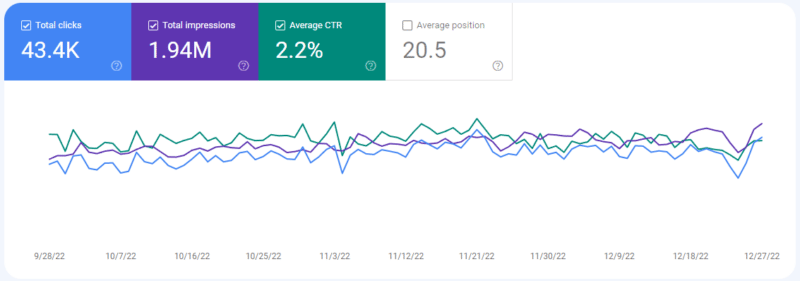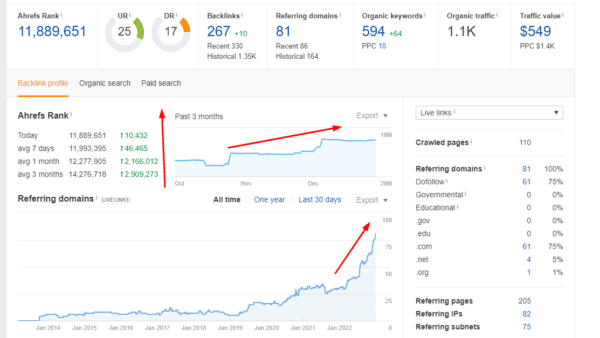
8 Tips for Creating SEO Optimized Blog Content
Everyone wants more traffic from Google, and everyone knows their website should have a blog.
But most people fail to create a blogging strategy that actually brings traffic to their site that will ultimately convert into sales.
Creating content for SEO, or search engine optimization, involves strategically planning and crafting blog content in a way that is optimized for ranking well in search engine results pages (SERPs).
SEO will drive traffic to your website, increase brand visibility, and ultimately lead to more conversions or sales… if done correctly.
Related Reading: The Top 10 Benefits of SEO
Before we dive into the strategies, I want to show you how fast it can work. Here is an example from a client who we have been helping with SEO for just 2 months.
You can see the immediate impact on their search presence and very solid growth:

Related > > What is a backlink and how do you get more?
Here are 8 tips for creating SEO optimized blog content.
-
Identify your target keywords with keyword research and planning: Before you start creating content, it’s important to identify the keywords or phrases that your target audience is likely to search for. You can use tools like ahrefs.com or SEMrush.com to research and identify relevant keywords. Once you have a list of keywords, you can use them to guide the creation of your content. This is the most important step because it sets the foundation for your whole SEO strategy!
-
Use your keywords strategically: When creating content, be sure to include your target keywords in a natural and relevant way. Don’t stuff your content with keywords or use them in a way that feels unnatural or spammy. Instead, use your keywords in a way that enhances the quality and readability of your content. The main goal here is to use the keyword(s) in a way that makes sense and gives the reader a good user experience.
-
Create high-quality, informative content: In order to rank well in search results, it’s important to create high-quality content that is informative and valuable to your target audience. This means researching your topic thoroughly and presenting accurate and up-to-date information. Again, you need to make sure the content provides a good experience to the reader and answers their questions well.
-
Use headlines and subheadings: Headlines and subheadings help to break up your content and make it easier for readers to scan and understand. They also provide an opportunity to include your target keywords. Make sure to use descriptive, compelling headlines that accurately reflect the content of your article. And another tip along the same line of thought; you should be using bullet points and lists often because it’s an easy way for people to consume your content.
-
Use internal and external links: Linking to other relevant and high-quality websites or pages can help improve the authority and credibility of your own content because it tells Google you are sourcing content from trusted places (just like you had to do in school when writing a paper and listing your sources). It’s also a good idea to link to other pages or articles on your own website, as this helps to improve the overall user experience and keep readers on your site longer. Internal linking will also pass “link juice” or “seo value” to those pages and help power them up.
-
Optimize images and videos: Including images and videos in your content can make it more engaging and visually appealing and provide a better user experience (are you noticing a theme yet?). Be sure to optimize these elements by using descriptive, keyword-rich file names and alt text because that will help guide Google as to their purpose and overall help your SEO.
-
Write good meta descriptions: Meta descriptions are short summaries of your pages content that appear in the search results page when someone has Googled your keyword. They provide an opportunity for you to convince searchers to click on your result, so it’s important to make them compelling and descriptive. When writing meta descriptions, be sure to include your target keywords and make them clear and concise. Focus on writing a compelling description that accurately reflects the content of your webpage and encourages clicks, and make sure to end with a call to action such as “Learn more here”.
-
Consider the user experience (the big theme!): I know we are talking about SEO but…you should really NOT be optimizing for search engines. It is most important to consider the user experience when creating content. This means making sure your content is accurately answering their question and providing best in class content.
Related > > 10 Benefits of using GA4
By following these 8 steps, you can create content that is optimized for SEO and helps to drive traffic and increase conversions on your site.
Remember to stay up-to-date on best practices and algorithm updates, as the world of SEO is constantly changing and evolving.
If you want help with SEO for your business, contact me here or at deviateagency.com to get a free consultation.
Related > > The Benefits of Content Marketing
How to use AI for optimizing SEO content
Tools that are powered by AI content can be used to make unique content that is optimized for certain keywords.
SEO tools that are powered by AI can look at the content of a website and suggest ways to make it better for certain keywords.AI-powered writing assistants can help writers make headlines and meta descriptions that are interesting and good for SEO.
Chatbots that are powered by AI can be used to answer customer questions and give them useful information This feature can help a website rank higher in search results.
Also, AI-powered tools can look at a website’s traffic and how people use it to learn how to make the content better for search engines. My prediction is that the application for AI plus Google Analytics will be powerful at some point.
